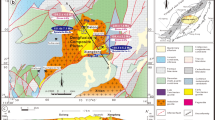Abstract.
The 1.15-Ga-old Ilimaussaq intrusive complex in South Greenland shows an extensive fractionation trend from alkaline augite syenite to various varieties of strongly peralkaline, agpaitic nepheline syenites. The peralkaline nepheline-bearing syenites crystallized between ca. 900 and 450 °C at 1 kbar and they are cut by late-magmatic hydrothermal veins with nepheline-absent assemblages of albite + aegirine + analcime ± sodalite ± Na–Be-silicates (tugtupite, chkalovite, sørensenite) ± ussingite (NaAlSi3O8*NaOH). Based on fluid inclusions and phase equilibria, these veins crystallized between 300 and 500 °C at 1 kbar. Textures indicate that the hydrothermal veins at least partly replaced earlier Ilimaussaq rocks. The occurrence of ussingite and tugtupite suggests that the late-magmatic fluids had strongly basic pH values. Speciation calculations show that the pH in fluids of the system Na–Al–Si–O–H–Cl mainly depends on the Na/Cl ratio and, to a lesser degree, on salinity and temperature. If the Na/Cl ratio is greater than 1, pH (at 400 °C and 1 kbar, where neutrality is about at pH 5) lies between 7 and 12. Because Na/Cl tends to decrease in the final stages of magmatism and during crystallization of the vein assemblage, pH of late-magmatic fluids generally should become more acidic, and only two processes can increase Na/Cl and, thus, pH: dissolution of a Cl-poor or Cl-free Na silicate or unmixing of an HCl-enriched vapour phase. Field observations and microtextures suggest that replacement reactions are responsible for the change to basic pH at least in some alteration assemblages. While replacement of 1 mol nepheline by 1 mol analcime would not alter the pH, the volume-conserving reaction \(1.85\;{\rm Ne} + 2.3\;{\rm H}_{\rm 2} {\rm O} + 0.19\;{\rm H}_{\rm 4} {\rm SiO}_4 = 1.02\;{\rm Anl} + 0.83\,\;{\rm Na}^ + + 0.83\;{\rm Al(OH)}_4^ - \) can be used to model the replacement process quantitatively, provided it occurred in a more or less closed system. Progress of this reaction leads to successively increasing pH of the fluid during fluid–rock interaction and stabilizes minerals such as ussingite and tugtupite. Transferring the two processes to a larger scale, it is proposed that the extreme 'hyper-agpaitic' assemblages at Ilimaussaq or at the Kola peninsula, which include copious amounts of very basic, water-soluble minerals such as trona, villiaumite or thermonatrite, are formed either in this way by autometasomatic reactions of late-magmatic fluids or melts (or supercritical fluid-melt-mixtures) with earlier crystallized rocks of the same plutonic complex or by large-scale vapour unmixing in the very final stages of magmatism.
Similar content being viewed by others
Author information
Authors and Affiliations
Additional information
Electronic Publication
Rights and permissions
About this article
Cite this article
Markl, G., Baumgartner, L. pH changes in peralkaline late-magmatic fluids. Contrib Mineral Petrol 144, 331–346 (2002). https://doi.org/10.1007/s00410-002-0401-6
Received:
Accepted:
Issue Date:
DOI: https://doi.org/10.1007/s00410-002-0401-6




